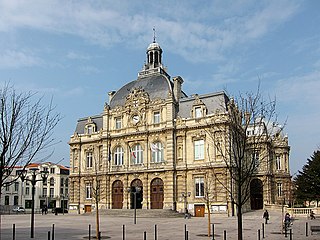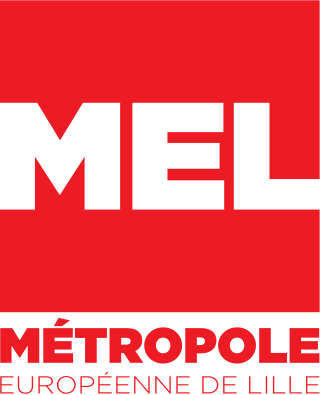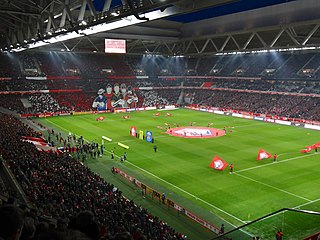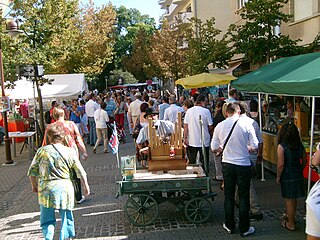
Bastille Day is the common name given in English-speaking countries to the national day of France, which is celebrated on 14 July each year. In French, it is called the Fête nationale française ; legally it is known as le 14 juillet.

Lille is a city in the northern part of France, within French Flanders. Positioned along the Deûle river, near France's border with Belgium, it is the capital of the Hauts-de-France region, the prefecture of the Nord department, and the main city of the European Metropolis of Lille.

Nantes is a city in the Loire-Atlantique department of France on the Loire, 50 km (31 mi) from the Atlantic coast. The city is the sixth largest in France, with a population of 320,732 in Nantes proper and a metropolitan area of nearly 1 million inhabitants (2020). With Saint-Nazaire, a seaport on the Loire estuary, Nantes forms one of the main north-western French metropolitan agglomerations.

Maine-et-Loire is a department in the Loire Valley in the Pays de la Loire region in Western France. It is named after the two rivers, Maine and the Loire. It borders Mayenne and Sarthe to the north, Loire-Atlantique to the west, Indre-et-Loire to the east, Vienne and Deux-Sèvres to the south, Vendée to the south-west, and Ille-et-Vilaine to the north-west. It also borders Ille-et-Vilaine in the north for just 20 yards (19 m), France's shortest department boundary. Its prefecture is Angers; its subprefectures are Cholet, Saumur and Segré-en-Anjou Bleu. Maine-et-Loire had a population of 818,273 in 2019.

Arras is the prefecture of the Pas-de-Calais department, which forms part of the region of Hauts-de-France; before the reorganization of 2014 it was in Nord-Pas-de-Calais. The historic centre of the Artois region, with a Baroque town square, Arras is in northern France at the confluence of the rivers Scarpe and Crinchon.

Pays de la Loire is one of the eighteen regions of France, located on the country's Atlantic coast. It was created in the 1950s to serve as a zone of influence for its capital and most populated city, Nantes, one of a handful of French "balancing metropolises". In 2020, Pays de la Loire had a population of 3,832,120.

Tourcoing is a city in northern France on the Belgian border. It is designated municipally as a commune within the department of Nord. Located to the north-northeast of Lille, adjacent to Roubaix, Tourcoing is the chef-lieu of two cantons and the fourth largest city in the French region of Hauts-de-France ranked by population with about 97,000 inhabitants.

The Métropole Européenne de Lille is the métropole, an intercommunal structure, composed by a network of big cities whose major city is the city of Lille. It is located in the Nord department, in the Hauts-de-France region, northern France – bordering both the Flemish and Walloon regions of Belgium. It was created in January 2015, replacing the previous Communauté urbaine de Lille, and covers that part of the Lille metropolitan area that lies in France. Its area is 671.9 km2. Its population was 1,179,050 in 2019, of which 234,475 in Lille proper. The annual budget of the métropole is €1,865 billion (2018).

Lille Olympique Sporting Club, commonly referred to as LOSC, LOSC Lille or simply Lille, is a French professional football club based in Lille, Hauts-de-France that competes in Ligue 1, the top division of French football. Lille has played its home matches since 2012 at the Stade Pierre-Mauroy. The 50,186-capacity retractable roof venue is the fourth-largest stadium in France.
Instituts d'études politiques, or IEPs, colloqually referred to as Sciences Po, are ten publicly owned institutions of higher learning in France. They are located in Aix-en-Provence, Bordeaux, Grenoble, Lille, Lyon, Paris, Rennes, Strasbourg and Toulouse, and since 2014 Saint-Germain-en-Laye. Their vocation is the study and research of contemporary political science. All students at the IEPs study a curriculum that is highly practical and broad-based, focusing on the full range of the social sciences across law, economics, finance, and management. These schools are considered as some of the most selective in France, mainly because they are the place where many political and business leaders are trained.

Saint-Quentin is a town in northern New Brunswick, Canada.

According to the French National Institute of Statistics INSEE, the 2021 census counted nearly 7 million immigrants in France, representing 10.3% of the total population. This is a decrease from INSEE statistics in 2018 in which there were 9 million immigrants in France, which at the time represented 14% of the country's total population.

Fourmies is a commune in the Nord department in northern France. The inhabitants are called Fourmisiens. It lies on the river Helpe Mineure. Since 2015, Fourmies has been the seat of the Canton of Fourmies, an administrative division of the Nord department. The canton was created at the French canton reorganization which came into effect in March 2015.

The Stade Pierre-Mauroy, also known as the Decathlon Arena – Stade Pierre-Mauroy for sponsorship reasons, is a multi-use retractable roof stadium in Villeneuve-d'Ascq in Northern France, that opened in August 2012. With a seating capacity of 50,186, it is the fourth-largest sports stadium in France and the home of French professional football club Lille.

A braderie or jaarmarkt is a type of grand yearly street fair and street market found in the Netherlands, Belgium, Luxembourg, Northern France and north-west Switzerland, mostly held in the summer months.

Moules-frites or moules et frites is a main dish of mussels and French fries originating in Northern France and Belgium. The title of the dish is French, moules meaning mussels and frites fries, with the Dutch name for the dish meaning the same. It is considered the national dish of Belgium.

The Lille Métropole Half Marathon is an annual half marathon foot race which takes place in Lille, France, in early September. First organised by the Association de Promotion des Événements Lillois in 1986, the race began as a marathon event before switching to the shorter distance in 1996. The course of the race begins in the Boulevard de la Liberté and finishes at the front of Lille's city hall on Rue de Paris.
The University of Lille is a French public research university based in Lille, Hauts-de-France. It has its origins in the University of Douai (1559), and resulted from the merger of three universities – Lille 1 University of Science and Technology, Lille 2 University of Health and Law, and Charles de Gaulle University – Lille III in 2018. With more than 80,000 students, it is one of the largest universities in France and one of the largest French-speaking universities in the world.

The Montsoreau Flea Market is the largest flea market in the Loire Valley, taking place all year the second Sunday of the month. Montsoreau is a small city named after the mount Soreau on which is built the famous château de Montsoreau, the only château of the Loire Valley to have been built in the Loire riverbed. Montsoreau is listed among the most beautiful villages of France, and both the village and the château are part of the UNESCO listed World Heritage Site of the Loire valley. The Montsoreau Flea Market includes all year, a hundred professional merchants and is located in the vieux port district, on the banks of the Loire river.

Place du Général-de-Gaulle is an urban public space situated in the commune of Lille, Hauts-de-France region. It is the town's historic main square. It has a grand-place style, which is typical of many cities in the former Netherlands.




















